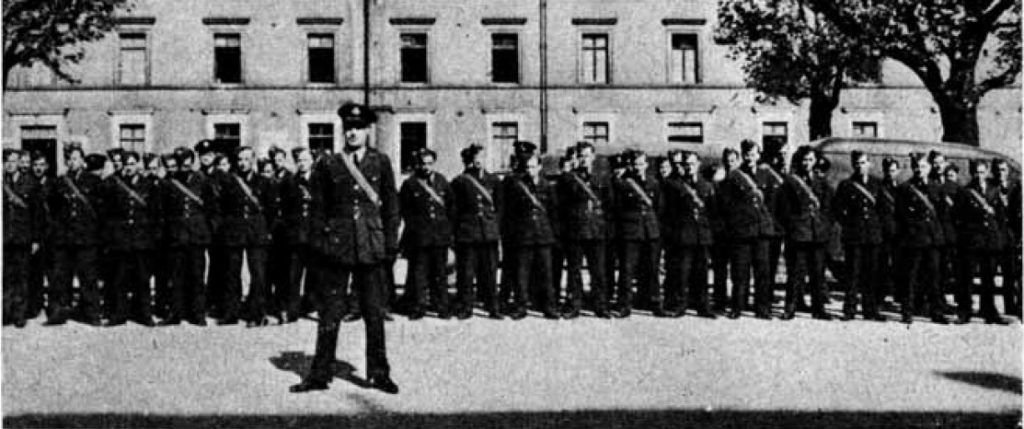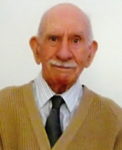Vic Flowers, G8QM, 15 March 2018
Victor (Vic) Flowers 10/2/1919 – 15/3/2018 (99)
Victor (‘Vic’) Flowers, G8QM, joined the RSGB on the 25th September 1935 and the family still has the original certificate he was issued with.
He spoke often of his time as an “Early Bird” (see later) but he also saw service in Singapore, India and England; North Creake in Norfolk and Flimwell in Sussex. During his time in Sussex he met his wife Dorothy, marrying in December 1947. They had two children, Tony and Angela. On demob from the Air Force he worked for the Home Office as a Wireless Technician based in the Regional Wireless Station in Cheveley, Newmarket (Suffolk). In 1969 he received a promotion and moved to the Regional Wireless Station Marley Hill, Gateshead in the North East of England. He remained at Marley Hill until he retired in 1979. Throughout his working career and retirement he kept an avid interest in amateur radio. At times this interest was limited as he was a carer for Dorothy. Sadly Dorothy died in 2007 and in 2011 he moved into residential care. Even in the care home he kept his interest going. He used a small handheld and an aerial that he attached outside the window every Sunday morning for his sked. As his eyesight deteriorated he wasn’t able to join in but still enjoyed listening. He would have many a discussion over the “good days” of amateur radio with his friend Ernie Colby, M5ERN, who visited him every week. He was so proud to top the Old Timers’ Honour Roll but he sadly passed away a few weeks later.
Tribute by Angela Taylor (daughter)
Vic was one of the very first British wireless operators who crossed the Channel to serve at the start of World War 2. He wrote of his experiences in the RAFARS journal QRV, summer 1987 edition, which was kindly forwarded to RSGB by his daughter, Angela.
A personal story of an “Early Bird” by Victor Flowers, G8QM, first published in QRV, summer 1987
After a few hectic days following mobilisation spent at a hotel in London and an uncomfortable night on the hangar floor at RAF Debden in Essex, 55 Civilian Wireless Reservists sailed from Southampton and arrived at the French port of Le Harve on the morning of 5th September 1939.
We were the first phase of the Civilian Wireless Reservists who served in France. Within hours we were on our way to our first base at a convent near Amiens and after a few days, the majority of us moved out to establish the HQ of an RAF Wing at a rather attractive chateau at Alanville. This did not last long as the Army arrived to claim the chateau as being essential to their own needs. However, by this time we were being split into small W/T Observer posts to establish part of the Wireless Intelligence (Observer) Screen along the French, Luxembourg and Belgian borders. After several short-term locations the main HQ of the WI Screen became based permanently in the “Caserne” French Army Barracks at Metz on October 11th 1939.
Each W/T Observer Post was made up of two RAF Wireless Operators, an Army Corporal and usually five other ranks, all ex-territorials who carried out the aircraft plotting and general duties. The communications equipment was a R1082/T1083 pack set powered by a rotary converter from 12 volt batteries charged by petrol generator. The base station and sections shared a common frequency and operated a strict “Radio Silence” system with pre-arranged operational codes. It is hard to believe now that we spent eight months of so-called “phoney war” along the German, Belgian and Luxembourg frontiers transferring from one to another as operational circumstances dictated. But personnel soon adapted to living and working under “front line” conditions in commandeered private property, farmhouses, and buildings, even for a time with French soldiers in Maginot Line fortress. Apart from the severe winter of 1940, life was not unpleasant and many friendships were made with French soldiers, and local village and townspeople.
When the German motorised columns advanced through Belgium my W/T Post was based in an old castle at Givet, right on the Belgian border. We had only been at the post for a couple of days when having been subjected to aircraft attack and the imminent danger of being cut off, we decided to evacuate after destroying stores and equipment. Splitting the party into three groups we set off in different directions. I was accompanied by the other RAF Operator (not CWR) and a RA Army private. I was fortunate in having a map so decided to cross the border to the Belgian town of Phillipeville. This was crammed with refugees and constantly under air attack but we managed to get a lift on a French supply truck which took us back over the border to a village called Signy-le-Petit. It was here that we were suspected of being spies or fifth columnists and put in the local jail. “Les Esponne, Dix Hommes” the locals chanted. The following day I managed to convince the Commander of the local French Army Garrison that we were RAF and not spies and he provided us with a pass in case we were stopped again. (I still have this pass). From then on we travelled mostly by night as by day all roads and verges were subjected to machine gunning and anti personnel bombing. We saw many innocent refuses, men, woman, children and their animals who had been killed by this indiscriminate warfare. During one of the attacks I was sheltering under a hedge about ten yards from the road when an anti-personnel bomb landed a few feet away but due to the soft earth, it failed to explode.
After several days walking, scrounging food and sleeping where we could, each day with its fresh experiences with German air attack, we caught up and got a lift with some Army lads who were making their way back to their base in Reims. When we arrived it was deserted – the parent unit had gone! They decided to try and reach another regiment known to them which was roughly in the direction we wished to go so we travelled with them. By another amazing stroke of good fortune we came across one of our own sections from the Wireless Intelligence Screen being taken back to base. We managed to join them and complete our journey back to Metz where there was no news of the rest of our post. Charles Gardner, the BBC War Correspondent, afterwards recorded our story in one of his books (AASF: Advanced Air Striking Force).

The last-ever full parade of the Early Birds, in Metz, France, on 21 May 1940 and published in the RSGB Bulletin, February 1941. Among those present on that occasion were GW6KY, G4DS, 5OI, 2BVN, 5BR, G4JY, 8CG, 6FZ, 2FNY, 3HG, 2BQC, 2BQZ, 8HB, 4FZ, 8TB and 2MB. The Officer is F/Lt Boundy.
After a few days at Metz, during which the town was subjected to long range shelling, the complete WIS advanced HQ was evacuated by train on the 21st May to the transit camp at Nantes where it was disbanded. A photograph taken before the unit left Metz appeared in the RSGB T & R Bulletin February 1941. An incident during the journey, which fortunately ended satisfactorily, but could have been much different, occurred at Angers, 80 miles from Nantes. The train stopped and appeared to be involved in a long delay so a few of us decided to leave the train to obtain some beer and food from a shop we could see a few hundred yards away. After completing our purchases we returned to see the train departing without us. In a siding we saw an engine and tender so we explained to the driver, who, to our great surprise, promptly took us on board and set off to follow the train to Nantes. I can still see the faces of our friends when we arrived with several crates of beer about 30 minutes after they did!
Nantes was a massive tented transit camp and that same evening we hear “Lord Haw Haw” on a radio say that the camp would be bombed. This was sufficient for me to step forward when volunteers were called to join certain operational squadrons and so found myself going back against the flow of Service personnel, all heading for the coast.
I soon ceased to be a wireless operator and became a “jack of all trades”, operating a “Chance Light” or airship floodlight to enable the Fairey Battle Bombers to land at night, re-fuelling and rearming aircraft and many other duties; my lack of any previous knowledge or experience was completely discounted! A further move to 73 Squadron and I have the sad experience of seeing the well-known fighter pilot ‘Cobber Kain’ killed when his hurricane hit the ground during a non-operational flight over his own airfield.
Eventually it became necessary to retreat and after several enforced changes of location it was Nantes once again and a quick move to St Nazaire, arriving on 17th June. It was an amazing sight, with piles of kit, rifles, stores etc stacked in every vacant space with servicemen roaming the quayside. A tender was loading troops and ferrying them out to ships in the bay. Although the boat was overcrowded, two RAF lads and myself managed to get up the gangway. But having gained a footing on deck I had a terrible premonition and feeling that I must get off. My two pals needed no persuasion and we literally fought our way back to the quay. The tender soon left and due to the air raids and utter chaos we decided to get out of town and found a route which led to the cliff top. Laying in the long grass we could see the ships in the bay quite clearly. I will remember the feeling of frustration at the lack of anti-aircraft opposition to the dive bombers skimming over our heads to attack the ships. During the afternoon we saw one ship receive a direct hit causing a tremendous explosion and a mass of smoke which soon obscured the scene. Later we learned that this was the Lancastria and that the tender we had failed to sail on had disembarked troops on her.
The following morning, having surveyed the damage from the air raids and realised the lack of any organised evacuation, we decided to carry on down the coast, fortunately getting a lift with servicemen on an army truck with the same idea. Brest was comparatively quiet and we were able to get on board the liner Strathaird, which took us safely back to Plymouth.
Although it was not until after the war that the full details of the sinking of the Lancastria became generally known, even today very few know that it was one of the worst sea disasters on record. It was estimated that about 5000-6000 men were on board the Lancastria when she was about to leave St Nazaire and over 3000 perished. I subsequently learnt that there were fellow Civilian Wireless Reservists aboard Lancastria at the time and sadly two lost their lives. These were John Buchan, G4QA, and R W Hunter, G3FL. Two others on board were Geoff Johnson, G2BJY and John Danks, G5DS: happily both were able to swim to safety.
Vic Flowers, G8QM, FAFARS 207
Category: Silent Keys












